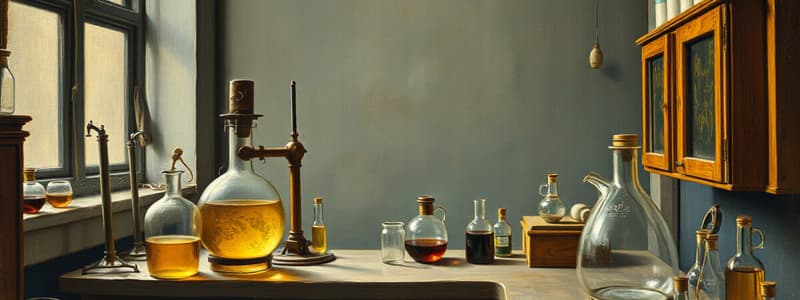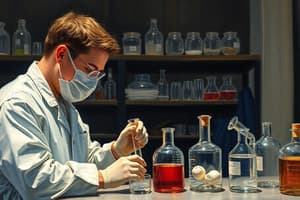Podcast
Questions and Answers
Which of the following is used for mixing, heating, and holding liquids during experiments?
Which of the following is used for mixing, heating, and holding liquids during experiments?
- Pipette
- Beaker (correct)
- Volumetric Flask
- Test Tube
What is a burette?
What is a burette?
A long, graduated glass tube used in chemistry for measuring liquids and gases.
What is the function of a funnel in a laboratory?
What is the function of a funnel in a laboratory?
- To mix chemicals
- To guide liquid or powder into a small opening (correct)
- To heat substances
- To measure accurate volumes of liquid
A graduated cylinder provides a greater margin of error than a beaker.
A graduated cylinder provides a greater margin of error than a beaker.
What do you call a device used to clean test tubes?
What do you call a device used to clean test tubes?
What should be worn in any area where chemicals are used?
What should be worn in any area where chemicals are used?
Which statement is true about the respiratory system?
Which statement is true about the respiratory system?
What is the primary gas exchanged by the respiratory system?
What is the primary gas exchanged by the respiratory system?
The respiratory system is responsible for the exchange of gases, primarily __________ and carbon dioxide.
The respiratory system is responsible for the exchange of gases, primarily __________ and carbon dioxide.
Flashcards are hidden until you start studying
Study Notes
Laboratory Apparatus and Their Uses
- Laboratory apparatus refers to tools and equipment used in scientific settings for experiments, data collection, and analysis.
- Beakers: Versatile containers for mixing, heating, and holding liquids.
- Test Tube: Finger-like glass container for holding small amounts of substances during experiments.
- Erlenmeyer Flask: Conical flask used for various liquid-handling processes; named after inventor Emil Erlenmeyer.
- Volumetric Flask: Used for measuring accurate volumes of liquids; more precise than beakers and graduated cylinders.
- Graduated Cylinder: Designed for accurate liquid measurements; smaller error margin compared to beakers, typically within 0.5-1%.
- Pipette: Tool for measuring and transferring precise volumes of liquids common in analytical chemistry and titrations.
- Burette: Graduated glass tube for measuring liquids and gases in chemistry applications.
- Funnel: Guides liquid or powder into small openings; made of materials like stainless steel, glass, or plastic.
- Clamp: Secures and supports other laboratory items during experiments.
- Test Tube Brush: Used for cleaning test tubes and narrow laboratory glassware.
- Test Tube Holder: Keeps test tubes in place, especially when hot.
- Test Tube Stand: Supports test tubes upright to prevent breakage or spillage.
- Bunsen Burner: Heats, combusts, and sterilizes substances in high-heat applications.
- Petri Dish: Cultures cells, including bacteria and molds, for scientific observation.
- Glass Rod: Mixing tool for chemicals and liquids.
- Tongs: Used for grasping and lifting heat-resistant materials during high-temperature reactions.
- Tripod for Bunsen Burner: Provides stability for various lab apparatus.
- Wire Mesh Gauze: Heat-resistant surface for containers to distribute heat evenly.
- Mortar and Pestle: Grinds solid chemicals into fine powder and crushes solids into smaller pieces.
- Triple Beam Balance: Mechanical weighing instrument for accurate measurements without power.
Common Laboratory Safety Rules
- Familiarize yourself with the locations of safety showers and eyewash stations for emergency use.
- Know emergency exit routes for quick evacuation.
- Avoid contact between skin/eyes and chemicals to prevent injuries.
- Minimize exposure to chemicals throughout experiments.
- Prohibit horseplay in the laboratory environment.
- Wear laboratory goggles or safety glasses in areas where chemicals are present.
- Post warning signs for hazardous materials and conditions to alert personnel.
- Prohibit the use of cell phones or earbuds in active lab areas to maintain focus and safety.
- Avoid wearing jewelry, which can pose safety hazards during experiments.
Respiratory System
- The respiratory system facilitates the exchange of gases (oxygen and carbon dioxide) between the body and the environment.
Studying That Suits You
Use AI to generate personalized quizzes and flashcards to suit your learning preferences.




